I’m not sure I can listen to things, I mean really listen, without doodling. It’s been like that as long as I can remember; my notebooks from school, from elementary through college, were about 75% drawings of cars and taillights and robots and spacecraft and noses and birds and hot dogs, often with legs, and so on, with about 20% actual notes and 5% food/beverage/undisclosed stains. I still work this way today.
Of course, thanks to the way the modern world works, I’m actually less likely to have pen and paper with me when I’m in a meeting or whatever to allow for doodling. Sometimes I have my iPad, sometimes not. Sometimes I have stranger doodling tools, which is what happened today, and is pictured above.
What you’re looking at there is a doodle of a Volkswagen Beetle I did – clumsily, with a joystick, hardly the ideal drawing tool – during an Autopian traffic meeting, on a machine that was arguably IBM’s biggest failure: the PCjr.
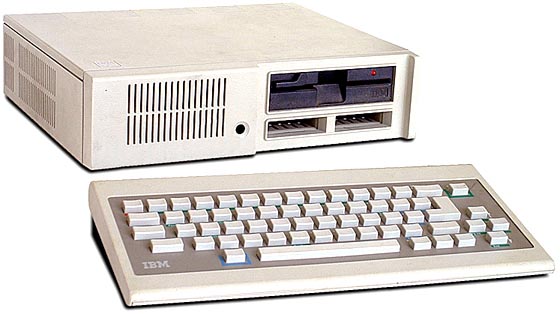
Do you know about the PCjr? It was IBM’s attempt to infiltrate the home computer market as opposed to the business market they were already dominating. They needed something cheaper and friendlier than their workhorse IBM PC, something that would compete with the Apple IIs and Commodore 64s of the world.
And it was an Edsel-level failure.
The machine IBM came up with was based on the same 4.77 MHz 8088 cpu of the PC, but in a smaller, plastic case, without the PC’s expansion slots, less memory, and a whole host of other cost-saving measures, including a wireless “chiclet” keyboard with hard plastic button-keys that nobody liked.
People hated that keyboard so much that even though the machine was only built for a little over a year, between March 1984 and May 1985, they actually came out with a more typewriter-like keyboard to replace the chiclet one.
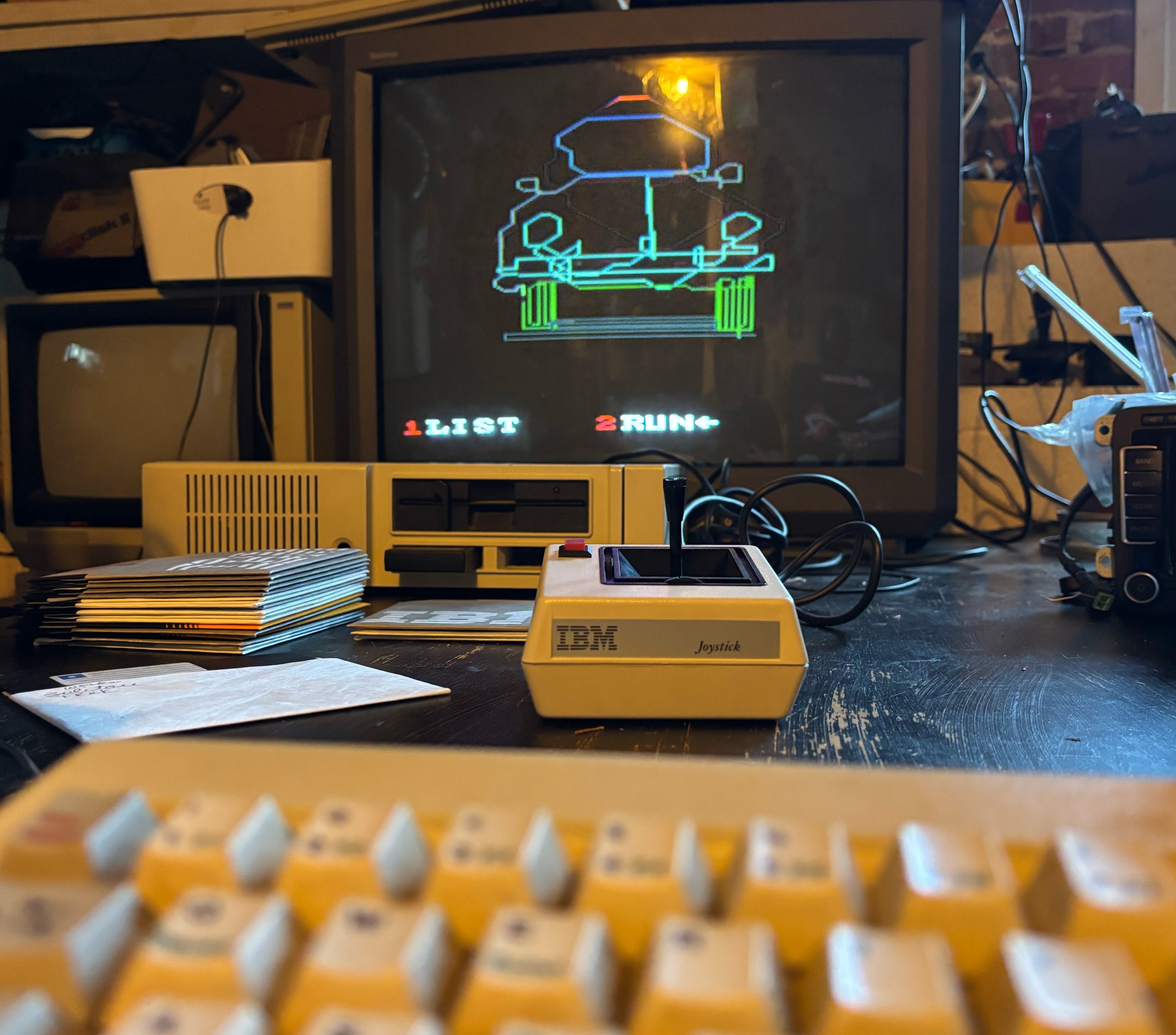
IBM’s ad campaign for the PCjr was massive, and used a licensed version of Charlie Chaplain’s Tramp character, but it always kind of creeped me out, in that way that mimes can creep me out. I mean, look:
Yikes, right?
Here’s a later commercial, showing the better keyboard:
The PCjr also used these weird proprietary ports that absolutely nothing else used, which drove everybody nuts, and while it was mostly IBM PC compatible, it didn’t really have the resources to run the most important software, which was frustrating.
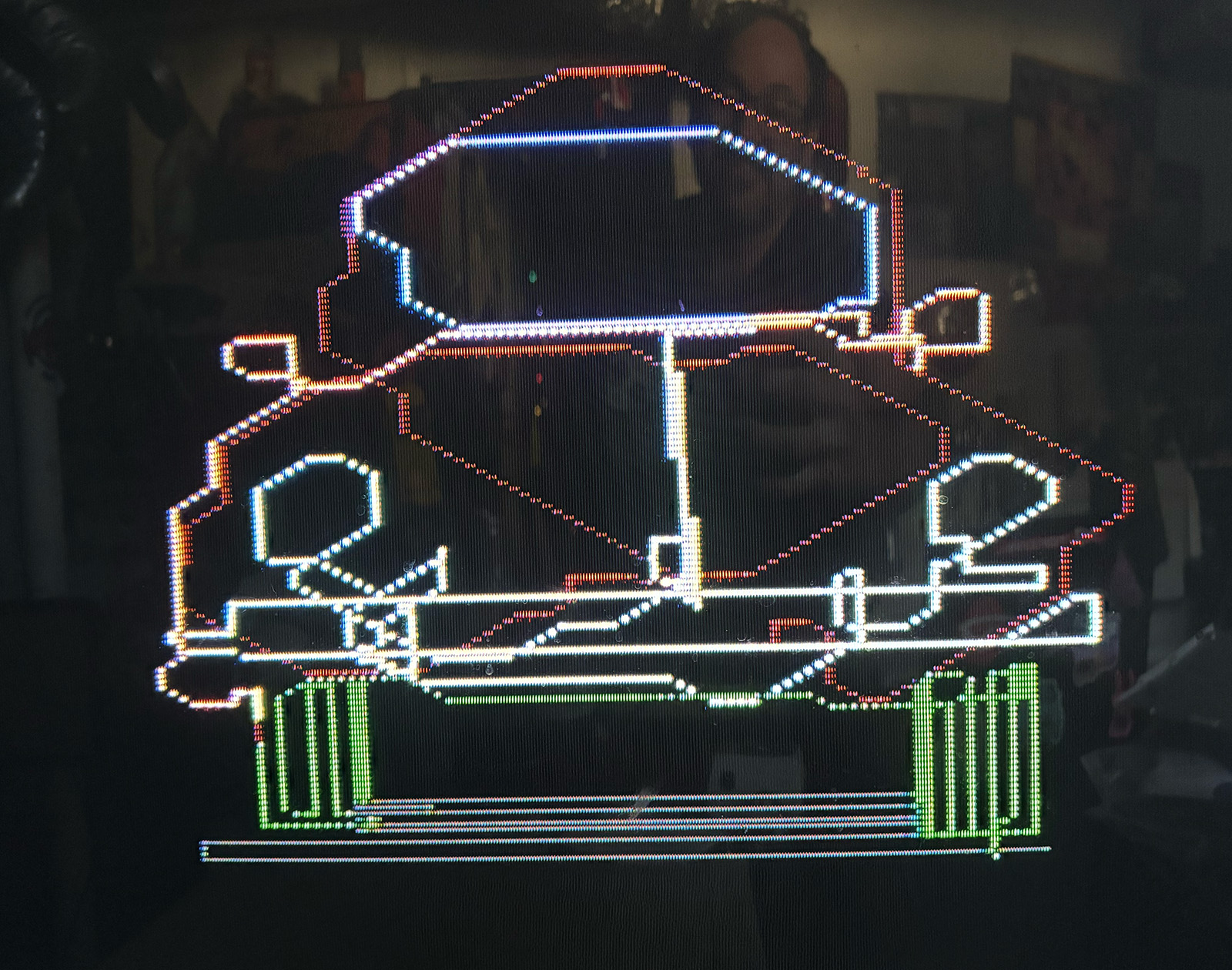
But it wasn’t all bad: the Junior had a real three-voice sound chip instead of just the PC’s simple beeper, and – important for my doodling fetish – had some better graphics modes than the PC’s CGA graphics system could offer.
One of these modes was a 160×200 pixel screen with full 16 color palette – a nice step up from the weird 4-color palettes CGA offered. This was the mode I used for my simple doodling program, resulting in that very disturbed-looking Beetle up there.
I wrote this little BASIC drawing program the other night to get familiar with the BASIC used by the PCjr (which is stored on a cartridge), since I’m investigating other platforms to make member birthday randomly-generated cars and whatnot, since I figured it may be fun to branch out from my go-to Apple IIs.
If you’re curious, here’s the simple program:
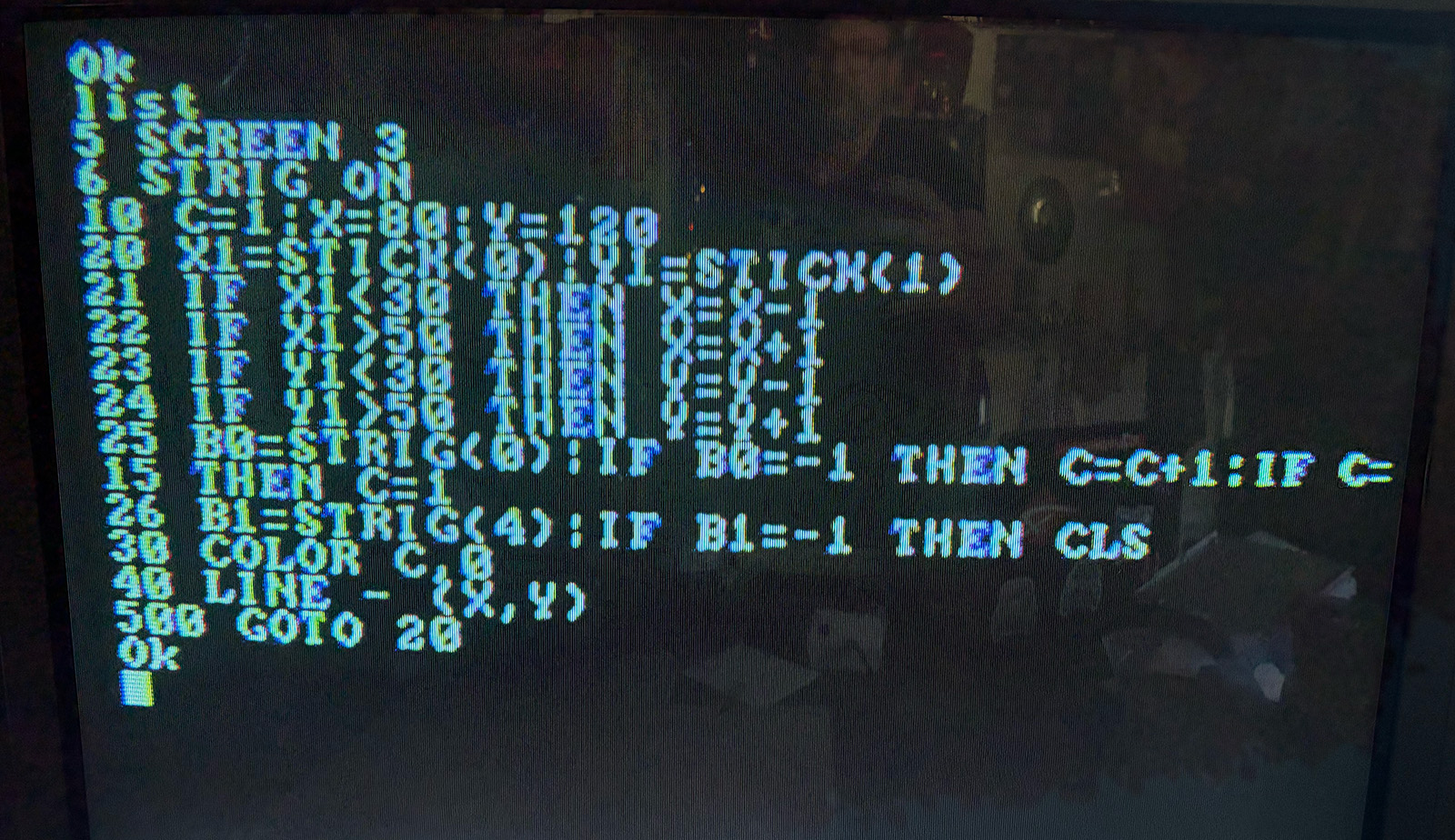
It’s pretty crude: I set the screen mode, activate the joystick button reading, set some variables, read the X and Y joystick axes, which I then check to see what direction the stick is getting pushed and adjust the X and Y coordinates accordingly, and then draw a line from the current point to the next point set by the joystick.
One button cycles through the 16 colors, the other clears the screen. That’s about it! It’s not exactly Photoshop. But, that’s what makes it fun – the crudeness and the limitations.
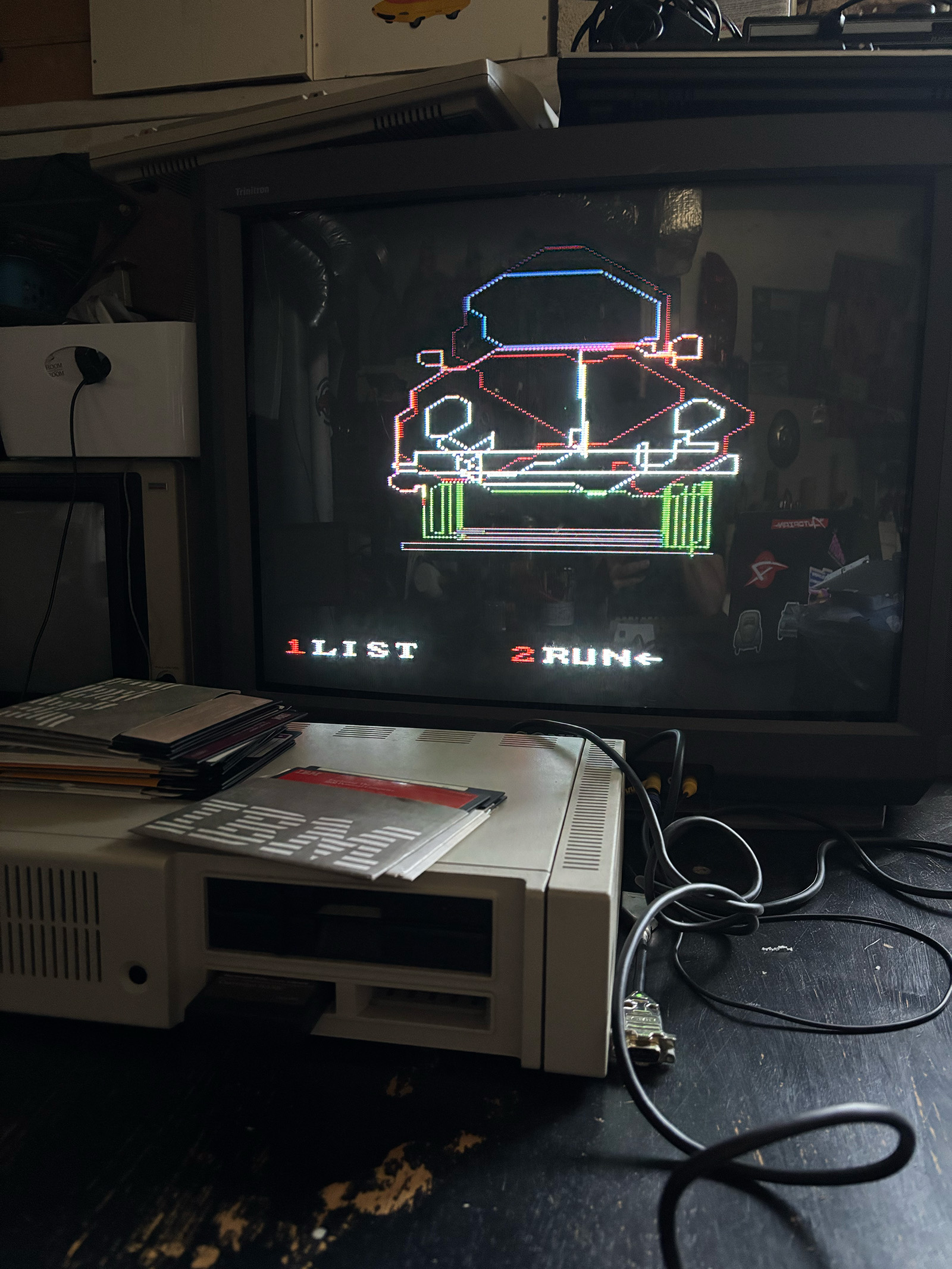
The joystick is a really terrible tool for this, but again, that’s part of the fun: use a bad tool on a notorious failure of a machine to make a crude picture of a car! What more would you want?
The limitations of the controls force a certain strange, angular-yet-ragged look to drawings, and I kind of like the peculiar result.
I don’t know why I like this stuff so much, but I do. And I appreciate that you let me bore you with this stuff. I’m still not sure I can make a randomized car generator like I did on the Apple II, but I may be able to, and I think I could get some interesting and colorful results if I’m smart, which is a pretty colossal if.
Now nobody tell David I was doodling during the traffic meeting. I was listening, honest!

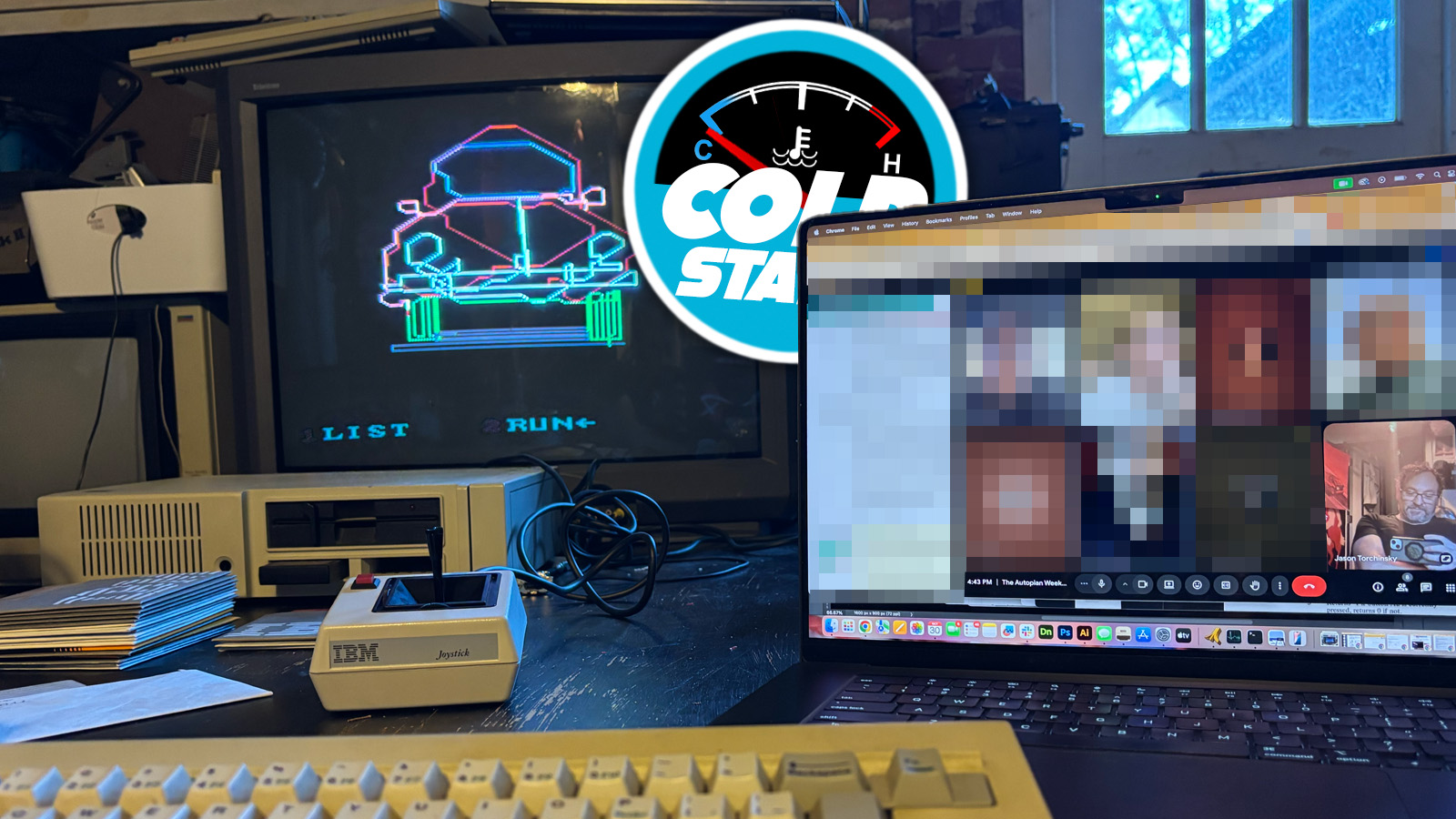







Unlike Edsel, though, Tandy went in and copied IBM’s homework to have a decent success in the 1000.
That’d be the equivalent of American Motors making a fanny-faced car with weird buttons on the steering wheel in like 1962 and then selling half a million of them.
I remember my parents having (and not using) a later PCjr with the revised keyboard. They both worked at IBM so they probably got some kind of discount. The only real memories I have of it is it sitting in the back room of our house sitting unused before disappearing and us not having a computer until our Gateway PC in 98.
I was a teen when the PCJr came out and even though I desperately wanted a PC I knew the PCJr wasn’t a good deal. IBM gear was very expensive and even though IBM made the PC standard the PCJr wasn’t good at being a PC. I wound up finally buying a 286 12MHz from a Computer Shopper seller in NJ if I recall correctly. Couldn’t even afford a hard drives at first, it had two 1.2MB 5.25 inch floppy drives.
Awesome!
The anonymized participants in that video conference look suspiciously like you may have been searching for a very specific type of content with safe search on moderate.
Not that I would know anything about that.
Hey I had PC jr (my Dad worked for IBM and they were probably giving them away at the end). It replaced the VIC-20 that I learned to program BASIC with. All the other IBM families we knew splurged for the real PC. I used Jr all through college to write essays but don’t know what happened to it after that.
Oh shit I refused to even look at PCjr they were expensive junk.
The Compaq PC and it’s IIRC Phoenix BIOS changed the World and enabled the march of the clones. Graphics eventually crawled along behind.
That reminds me I need to recycle a ton of hardware I’ve hoarded.
Hey Jason. Since you mention your doodling books,it would be awesome if you still have some of those and would share the pages here.
I,and probably many here also was drawing cars and shit all the time in shool instead of listening or whatever the other kids were doing.
I don’t think I realized the things had cartridges a la Nintendo
My father gave me the IBMjr. so I could be one of few elite students at my high school to have his own PC. Half of times, I lost my work due to the glitches in the system. So, I had to save my work every five seconds, bordering on OCD level.
Its propietary Micro Channel Architecture (MCA) meant I couldn’t upgrade it any way we could with IBM PC (that we got in 1981). We added few kits for second floppy drive, memory expansion, and like. The slight vibration from the desk would glitch the data transfer between memory expansion, second floppy drive, and processor. Frequent reboots killed my motivations to write reports, papers, etc. on PCjr.
In the end, the IBM PCjr. with kits cost much more than the IBM PC.
The only redeeming quality was its excellent keyobard (not that chicket version!). I regretted not keeping it for posterity…
With a jrIDE and the PC compatibility cartridge, I quite enjoy my PCjr!
People forget just how many brands of personal computers there were on the market back in the early 80’s. It was like a gold rush to build PC’s. It was at the same time a Cambrian explosion of creativity, and also , truth be told, a torrent of garbage. All these computers were pretty much useless in the average household and buggy as heck when you tried to do anything. It wasn’t until the Macintosh came out, that PCs actually became useful and usable.
Kind of a similar situation with smart phones. Smart phones existed before the IPhone, but they were clunky and buggy. Then the IPhone came out and the smart phone became a useful and usable thing.
I bought a Commodore 64 in 1983 and then a Fat Mac in 1985. For my uses (word processing and the occasional game) the C64 was pretty stable.
Maybe in a void it would take me a second to recognize the image, but whole browsing the homepage it was immediately obvious. I love how much an image can be distorted from the real thing, and our pattern-loving brains figure out a connection anyways.
The Chaplin character was IBM’s “spokesman” for all their stuff in that era, not just the PCJr. The Tandy 1000 came out and ate the Jr’s lunch, then beat it up and gave it a swirly.
Had one. I’ve been waiting for a “Former PCjr support group” to be formed, but assumed we were the only family that owned one… We too had the expansion slot bolted to the side. And that controller remains to be one of the finest pieces of engineering I ever recall holding in my hand. The grooves on the end didn’t make your thumb bleed for at least the first 15 or 20 minutes.